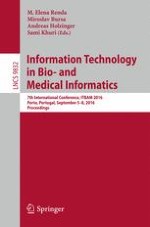2016 | Book
Information Technology in Bio- and Medical Informatics
7th International Conference, ITBAM 2016, Porto, Portugal, September 5-8, 2016, Proceedings
Editors: M. Elena Renda, Miroslav Bursa, Andreas Holzinger, Sami Khuri
Publisher: Springer International Publishing
Book Series : Lecture Notes in Computer Science
